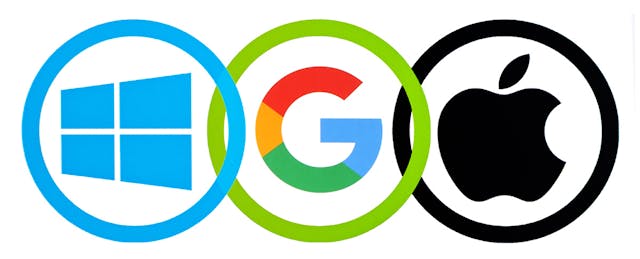It’s terribly confusing, but perhaps no coincidence, that three of the world’s most prominent consumer technology companies—Apple, Google, Microsoft—each boast a “Classroom” tool aimed at K-12 educators and students. After all, what better way to secure a foothold in the market than impressing one’s brand to future consumers at a young age?
Even more confounding is all three Classrooms offer functionalities that one might find in a learning or device management system. So what’s what—and what should educators and administrators know when choosing between the big three? Here’s a breakdown, by order of their release. (For a quick summary, see our comparison chart at the bottom.)

Google Classroom
Price: Free with G Suite for Education
Device compatibility: Android, iOS and any web browser
Number of users: More than 20 million teachers and students globally
Core Features:
- Teachers can create and share assignments
- Students can collaborate online
- Streamlines feedback on student work
- Option for guardians to receive student progress updates
Updates and Upgrades: The first of the “Classrooms,” Google Classroom launched in August 2014. Since then, the company has kept a steady rhythm of new features including new features like email summaries for guardians, polling capabilities, and easier data transition for graduates. Google Classroom, which is a core app within G Suite for Education, is reminiscent of learning management systems like Schoology or Blackboard or Canvas—but is free for any educator and works on Chromebooks, iPads and other mobile devices.
Although it is most frequently used to create, collect and offer feedback on assignments (which multiple students can work on at once), Google Classroom also has tools like Stream, a communication channel for teachers and students, and notifications to nudge students about upcoming assignments and due dates. The company also recently unveiled an annotation feature that allows students to draw and show work directly onto digital assignments. Students and teachers using the platform have access to and work within Google Suite products including Docs, Sheets, Slides and more.
What educators say: G Suite is what’s hot in education today, according Aaron Roberts, innovation coach at Mason City Schools in Ohio. Roberts has worked with both Apple Classroom and Google Classroom but says he’s impressed by the latter’s “easy to organize and easy to understand” platform, as well as the company’s attempt to build out features for personalization. “I don’t see anything like that coming out of Apple,” he remarks.
Jason Klein, assistant superintendent for technology and learning for Maine Township High School District 207 in Illinois, echoes Roberts sentiments and says many teachers in his district have been turning to Google Classroom on their own. “It’s an easy path to entry for teachers, and makes the management of differentiation easier.”
The tool isn’t perfect though, Roberts warns: “The development cycle brings cool new things but it feels very slow. There is no gradebook and quiz feature is still limited.” And while Klein applauds the free product (saying “the price can’t be beat!”) Roberts is a bit more skeptical. “That worries me because Google tends to kill off products they can’t monetize.”

Apple Classroom
Price: Free*
Device compatibility: iOS, specifically iPads only
Core Features:
- Teachers can control student’s devices in the classroom
- Students can share work via Apple TV or other Mac screens
- Keeps students are on the same app or webpage during class
Updates and Upgrades: Apple Classroom officially hit the app store in March 2016. It’s not so much a learning management system as it is a device manager specifically for iPads or, as the company calls it, a “teaching assistant.” What that looks like for teachers is the ability to turn on and off students’ devices, push apps and websites out to all iPads in the classroom, group students for activities, and allow teachers to display student work to the entire class via AirPlay. From their own iPad, teachers can take a peek at what is on an individual student’s screen, giving them the ability to see students’ work without walking around the room.
Though free to download, Classroom must be configured with mobile device management (MDM) software (like Jamf, which can cost between $4 to $6 per device) in order to operate. However, the company has plans to change that soon so teachers can add students manually to their class without any additional IT support or software costs. Other planned updates include the ability for teachers to mute devices and share documents or websites via AirDrop.
What educators say: Comparing Apple Classroom to Google or Microsoft Classroom is sort of like comparing apples to oranges. Carl Hooker, a director of innovative and digital learning at Eanes Independent School District in Texas, works with both Google Classroom and Apple Classroom in his district. “The only commonality is they are both called Classroom,” he says.
For lower grade levels, Hooker says Apple Classroom has been a hit. It has helped teachers in his district easily push apps or webpages to students who might have trouble navigating the device, and share students work—like an up close view of a science experiment—to the whole class on an Apple TV. And for upper grade levels, he says teachers have benefitted from being able to monitor student activity. But there has also been some issues with that feature as well. “Within a week, middle and high school students discovered a blue bar on the screen meant the teacher was watching their device,” Hooker explains. “They figured out they could switch to airplane mode [so a teacher can’t see their screen].”

Microsoft Classroom
Price: Free with Office 365 Education
Device compatibility: iOS, Android, Windows and any web browser
Core features:
- Teachers can create and share assignments
- Students can collaborate online
- Streamlines feedback on student work
- Communication channel lets teachers and students chat
Updates and Upgrades: The newest Classroom on the block, publicly released on August 2016, is Microsoft Classroom. Like Google Classroom, Microsoft’s offering is a homepage for classroom assignments and resources. The platform, which comes free for schools or districts using Office 365, works with OneNote Class Notebooks—a digital workspace where students can find and share assignments, receive feedback and collaborate digitally.
Unique is OneNote Class Notebook’s ability to also integrate with more than 30 different learning management systems such as Canvas, Schoology or even Google Classroom. This allows for additional functionalities like delivering grades to third-party gradebooks. Many features on the platform appear similar to Google, such as Microsoft Forms (which allow teachers to quickly create and share surveys and quizzes with students), Conversation (Microsoft’s answer to Google Stream), and a note-taking feature where students can use a stylus to write directly on their documents.
Within Microsoft Classroom, students can access and work with Office 365 tools including Word, Excel, PowerPoint and more. The platform is also integrated with Microsoft tools like Sway, a digital storytelling app that lets teachers create things like web-based lessons and newsletters.
What educators say: “If imitation is the most sincere form of flattery, then Microsoft is doing a good job of that,” says Jason Klein. “It’s a straight Google Classroom knock-off.” But the assistant superintendent means that in an endearing way. “If we were a Microsoft District, I would absolutely use it.”
Rob Dickson, executive director for Omaha Public Schools in Nebraska, has been working with Microsoft Classroom for nearly two years as an early adopter and piloter for the program. In addition to the ability to create assignments and post to different classes, he says Microsoft Classroom makes for a great “intro” learning management system for teachers.
“What I like about this is it allows for co-teaching. As you’re building teachers digital literacy level, you can pair them with other teachers to get them up to speed,” says Dickson, who worked with Google Classroom at his previous district. “For many of our staff, I look at this as an initial toe dip into LMS.”
| Core Features | Apple | Microsoft | |
| Create & distribute assignments | Yes | No | Yes |
| Built-in gradebook | No | No | No |
| Post updates & announcements | Yes | Yes | Yes |
| Content and data integration with third-party apps | Yes (list) | No | Yes (list) |
| Monitor student devices | No | Yes | No (but can integrate with tools that make this possible) |
| Save & store documents within Classroom | Yes | No | Yes |
| Parent/guardian notification | Yes | No | No |
How widely any of these Classrooms are adopted will likely depend on how well their supporting devices do in the market. And while Google’s Chromebooks may have the lead these days—accounting for more than half of Q1 2016 device sales in the U.S. education market), Microsoft’s newly-released low-cost Windows 10 PCs could give the search giant a run for its money.


